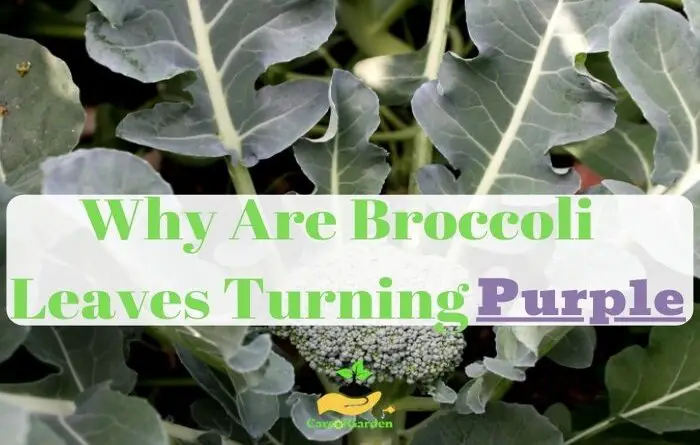5 Surprising Reasons Your Broccoli Leaves are Turning Purple?
One of the most frequently asked question is why are broccoli leaves turning purple? The most common answer is that the soil simply does not have enough phosphorus , in other words, you initially forgot to add phosphate fertilizers for digging or applied too little.
Nutrient deficiencies in plants are difficult to detect and are often misdiagnosed. When nutrients such as magnesium, calcium, potassium, phosphorus, and nitrogen are lacking, broccoli plants respond in a variety of ways, often in leaf color changes.
Purple discoloration along the veins on the underside of the leaf is a clear symptom of phosphorus deficiency.
Causes of Broccoli Leaves Turning Purple
| Causes of Broccoli Leaves Turning Purple |
|---|
| 1. Phosphorus deficiency |
| 2. Nitrogen deficiency |
| 3. Temperature |
| 4. Diseases and pests |
| 5. Wrong pH value |
1. Phosphorus deficiency
The most common cause of broccoli leaves turning purple is a phosphorus deficiency. This deficiency can occur for various reasons: The first one is simply not enough phosphorus in the soil. The second reason is if the phosphorus absorption in broccoli is impaired.
The purple color comes from a pigment that forms when there are more sugars in the leaves than the broccoli plants can use. A low concentration of phosphorus inhibits the movement of sugars out of the leaves, while in dry and cold soil the roots stop growing and the movement of sugars to the root stops, both conditions cause broccoli leaves to turn purple.
This can be the case, among other things, if the air and soil temperatures are too low. The pH value of the soil also plays an important role, because if it is too high or too low, phosphorus uptake is also impaired.
In this specific case, there is a lack of phosphorus. According to Wikipedia, phosphorus is a chemical element that is essential for cellular energy supply. It also affects the carbohydrate balance, photosynthesis and water balance of the plant.
If there is a deficiency, purple spots appear on the broccoli leaves and, if this lasts longer, the plant develops an unnatural, rigid, upright habit. In addition, newly formed leaves remain extremely small.
If the leaves turn purple, there is only one way out feeding on phosphorus fertilizer. It can be superphosphate or an independently made product on the basis of manure and other similar components.
2. Nitrogen deficiency
Nitrogen deficiency delays protein synthesis, preventing the plant from performing optimally. In order to continue to meet its nitrogen needs, the broccoli plant breaks down its own proteins. This breakdown of proteins produces a surplus of carbohydrates that turns the stems of the broccoli leaves and the stem of the plant purple.
3. Temperature
Purple leaves can also be an indicator that the broccoli plant are too cold. If the soil is cold, the roots cease to receive nutrients, since the plant directs all its forces to the heat, the lower part takes on a darker shade. After the heating problem is solved, the shade of the leaves will return to normal.
It is better to install fluorescent lamps near the sprouts. A purple tint in broccoli leaves appears due to the low production of chlorophylls, which are responsible for the green color of the foliage.
This happens if the seedlings have not been hardened in the open air or transplanted into soil not heated to the minimum necessary 57-60°F (14 -16 ° C).
In such situations, the seedlings should be covered overnight with plastic cups or bottle caps to protect them from the cold. Damaged leaves should be removed.
If your broccoli leaves is turning red or purple after a particularly cold night, take a good look at them over the next few days. If they continue to grow normally, there is nothing to worry about.
4. Diseases and pests
The appearance of pests in the soil or greenhouse allows you to understand why broccoli seedlings turn purple. Plant culture can be affected by fungal diseases, which are difficult to get rid of.
The purple color on the broccoli leaves appears after the black leg, the pathogen that is in the soil. Most often, a terrible fungal disease, the black leg, can lead to purple leaves.
If it hit the seedlings, it is difficult to save the broccoli leaves: the roots are affected and the nutrition of the plant is disrupted.
If the disease has attacked adult plants, then you can help in the initial stage. But it is better, if only a few plants are affected, to destroy them, and treat the rest with colloidal sulfur preparations.
When the first dark spots appear on the leaves, you can try using potassium permanganate. The lower part is treated with a 1% solution, trying to get under the root. You can rake the soil to make the action more effective. Watering with potassium permanganate should be generous: up to 1 liter per plant.
5. Wrong pH value
Soil acidity affects phosphorus absorption. The higher this indicator, the worse the absorption of the microelement. Broccoli grows well in loamy soil with neutral (or near neutral) acidity – 6.2-7.5. Lime or dolomite flour, wood or peat ash, chalk or hydrated lime can help lower the pH.
The substrate or soil plays an essential role in the growth and health of broccolis. Ideally, the substrate is as loose and permeable as possible, so that the broccoli plants can absorb the nutrients they contain well.
It is therefore advisable to check the pH of the soil when broccoli leaves turn purple and if necessary, to take the following steps:
- Lower pH: peat, compost, mulch layer or coffee grounds
- Increase pH: Potassium hydroxide, potassium bicarbonate, or ground lime
How to prevent purple leaves on broccoli
Here are the steps to prevent purple leaves on broccoli:
- Before planting broccoli soak the seedling in a weak mix of potassium permanganate
- Make sure the temperature of the air is around 68-70°F (20℃)
- Verify the pH of the soil before planting broccoli, it must be neutral (6.5-7 pH)
- The soil should not be soggy and also not too dry.
- Use a drip irrigation system, make sure moisture has not penetrated the top and stem.
- Use organic matter to fertilize.
Why do plant leaves turn purple?
When you notice a plant with purple leaves instead of the normal green color, it is most likely due to a phosphorus deficiency. All plants need phosphorus P to produce energy, sugars, and nucleic acids.
Young broccoli plants are more likely to show signs of phosphorus deficiency than older plants. If the soil is cool at the beginning of the growing season, a phosphorus deficiency may develop in some plants.
Plant deficiencies are often fostered by various factors, including poor soil, insect damage, too much fertilizer, poor drainage , or disease.
Why is my broccoli turning red?
Broccoli turning red can occur for several reasons. One possible reason is that the broccoli has been exposed to high levels of light or heat, causing it to develop a reddish or purplish hue. This can happen when the broccoli is grown in warmer climates or is exposed to direct sunlight for prolonged periods of time.
Another possible reason for red broccoli is genetic variation. Some varieties of broccoli are naturally reddish or purple in color due to the presence of anthocyanin pigments. These pigments are responsible for the red or purple coloration in many fruits and vegetables, including blueberries, grapes, and red cabbage.
Why is the top of my broccoli purple?
The top of your broccoli turning purple can be due to a few different reasons.
One possible cause is that your broccoli variety is naturally purple or reddish in color due to the presence of anthocyanin pigments. These pigments can be more concentrated in the top of the broccoli, resulting in a purple color.
Another possible cause is exposure to cold temperatures. Broccoli is a cool-weather crop and can tolerate some cold temperatures. However, if the plant is exposed to prolonged cold temperatures, especially at night, it can cause the broccoli to develop a purple color, particularly at the top. This is known as “cold stress.”




